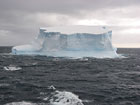

 | |||||||||||||||||
|
|
Journals 2007/2008Mark Goldner
November 22, 2007 62° 18.00' S, 60° 16.37' W Well, almost. Today, we reached our southernmost point in the cruise, and we turned around to begin our trip back up North and another set of ocean-water testing. Before we turned around, however, we were treated to a several hours long sail along some of the Shetland Islands at the tip of the Antarctic Peninsula. What a breathtaking sight! For hours, many of us stayed up on the bridge watching the spectacular icebergs and mountains of the islands as we cruised by.
The landscape of those islands is quite beautiful but also very imposing. The icebergs are much larger than I imagined - probably at least 100-200 feet high, and then at least 1000 feet across. Most of the ones we saw were probably locked to the sea floor; the ocean is quite shallow there and given how much ice is under the water, it makes sense. They didn't seem to be floating, at any rate.
There were also many smaller pieces of floating sea ice. I learned that the tiniest bits are called "growlers" and the larger ones "berg bites".
After out little sightseeing tour, we headed back up North. The wind has picked up considerably - right now the winds are 30 knots and we are rolling with some 15-18 foot waves. On one of the many computer screens in the lab, you can check the amount the ship is rolling (side-to-side) or pitching (front-to-back). On one large swell an hour ago, the boat was rolling at 13 degrees, and pitching at 7 degrees. That's enough to make it quite difficult to do much. As we head back North, we'll be checking on each CPIES to make sure it is collecting and transmitting data properly. We'll also be doing a "CTD cast" at every CPIES site. The CTD (conductivity/temperature/depth) is a process of collecting information about those three variables at different depths. It involves a package of large bottles that are sent down open, and closed at certain depths. That way water samples from different depths are collected and can be tested. Unfortunately, the seas are too rough for us to do the CTD casts. The way this ship is designed, when the CTD package is sent down, there's a risk of the package smashing into the ship, damaging the instruments. This risk increases dramatically if the seas get too rough. So right now we're just waiting in the southern Drake Passage until the seas calm down.
For Thanksgiving today, the cooks made us a nice Turkey-day meal. Turkey, stuffing, mashed potatoes, collard greens, cranberry sauce, and of course pies and cakes! It was nice to have a little taste of the holiday, even out here in the Drake Passage! |
||||||||||||||||




